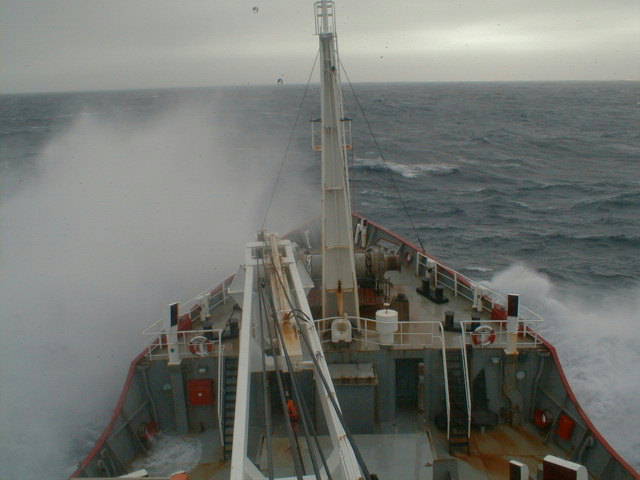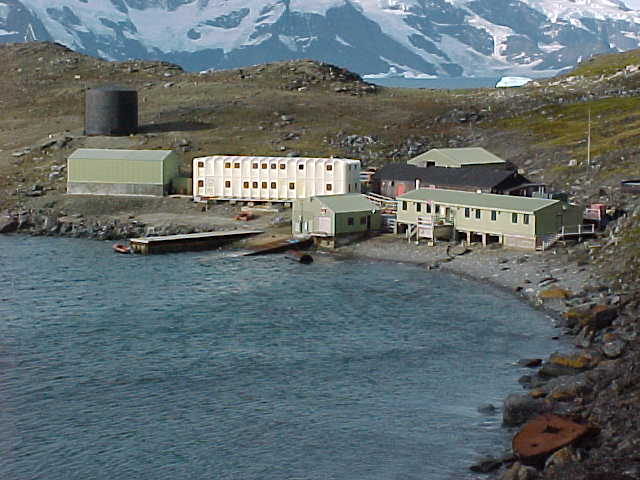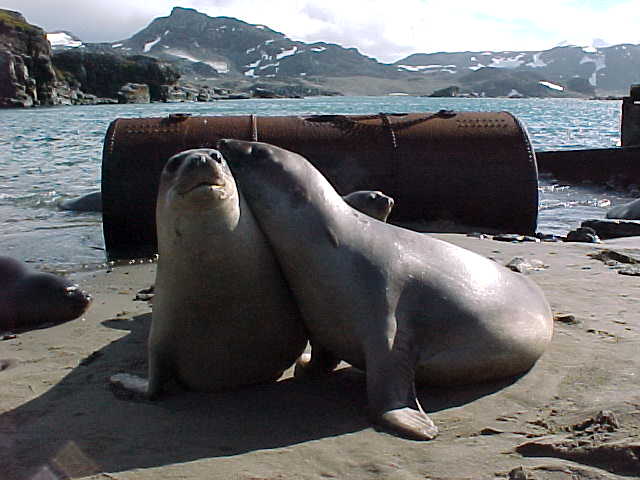| Date | Sunday 4th April 1999 |
| Time | 1200 (UTC-3) |
| Position | Latitude 53°36' South
Longitude 047°57' West |
| Next destination | Montevideo |
| ETA | 9th April 1999 |
| Total distance | 24323.6 Nautical Miles
(Since departing Grimsby on 17th October 1998) |
| Current weather | Overcast, slight mist. Vessel rolling and pitching moderately to rough seas and large swell. |
| Wind | North Westerly Force 7 |
| Sea state | Rough |
| Air temperature | 7.2°C |
| Sea temperature | 4.5°C |
Ship's
track - Updated every six hours from the weather observations sent
to Bracknell weather centre - direct from BAS
homepage.
Summary
The Bransfield sailed from Stanley at 1900 on Sunday 28th March, on a nice calm evening. A large number of people came down to the FIPASS to wave goodbye, as the ship would not be returning until November. The ships horn was sounded as we headed towards The Narrows and this was replied to by numerous car horns......but not as loudly!
Monday and Tuesday proved to be uneventful, with good conditions and a very pleasant passage towards the South Orkney Islands. Wednesday morning saw several moments of excitement. As the vessel was approaching the Inaccessible Islands and Coronation Island, icebergs were starting to be detected on the ships radar. Whilst nothing unusual about this, the behaviour of several of them did not look right and it soon became apparent that we were not alone down here, there being four fishing vessels fishing off the islands. At the same time that we were all looking at these ships, a pair of humpback whales are seen just a few hundred metres off the bow and everyone now is watching them 'blowing' and sticking their fins out of the water. If this was not enough for one morning, before the humpbacks have dropped astern of the ship, a southern right whale is spotted lying on the surface at about the same distance off the ship and we now all watch as we pass by. The sky even cleared and the sun came out too, a lovely welcome to the South Orkney Islands. At 1500 the Bransfield anchored in Borge Bay and Erebus was put in the water and took some cargo ashore, required for the closing of the base. A quiet night then ensued and at 0600 on Thursday morning Tula was in the water to make a start on the removal of cargo from the base. At the same time two of the divers on board prepared to do work just off the jetty at the base, to replace a tide gauge. At 0800 two inflatable boats were deployed with the remaining divers to undertake work in the vicinity, all part of the Gene Flow experiment. The sites chosen were: Outer Rocks, Bare Rocks, Billie Rocks, Robin Rocks (north and south) and Powell Rocks. Due to the regulations regarding the amount of time the divers were allowed in the water, this took the two days to complete. The replacement of the tide gauge also took longer to complete than anticipated and was not finished until the Friday morning. Whilst replacing the tide gauge the divers had lots of fur seals to keep them company and generally get in the way of the work. The seals certainly enjoyed the divers company, although I am not sure the feeling was mutual. The weather, although overcast, was very good for cargo work with little wind and the remains of a swell from earlier in the week. During the Thursday afternoon a survey ship was spotted off of Signy, although not visible from the ship, and following some thought on which one it could be it was decided to try the Argentinian vessel Almirante Irizar and so a call was made on the international VHF calling channel and it was indeed the Irizar. There is an Argentine base on Laurie Island, about 50 miles from Signy, called Orcardas, and the Irizar had just completed a relief there and was on her way to Jubany Station in the South Shetlands, visited by us the previous week. Having wished each other safe sailing and a Happy Easter the call was completed.
The final operations of closing and securing Signy base for the forthcoming winter were completed during the course of Friday morning and by mid-day all personnel were back on board, with the seven base personnel from Signy now embarked, the anchor was weighed and Bransfield started the first part of the long journey back to the UK. At 1400 the James Clark Ross came into view (she is currently doing a science cruise with the University of East Anglia) and was in-between science stations, just south east of the Inaccessible Islands and the two ships were soon steaming in convoy for a short period to allow a photo opportunity. Once all photos had been taken the James Clark Ross broke away from us with several blasts on her horn, returned by our horn, and continued on her way east to her next science station and Bransfield headed northwards. By dinner time, once clear of the islands, the sea state had deteriorated and the vessel was starting to roll easily. The forecast was that this would be the case for the next few days, and certainly Saturday proved to be somewhat lumpy with winds of about 30 knots from the west throughout the course of the day.
Any thoughts of an improvement in weather for Sunday were dashed. Most people had a somewhat sleepless night and Sunday morning proved to be just as bad as Saturday night. The ship continued to roll easily and to do anything was difficult. As I sit and write this page I am having to stop myself from sliding across the room and keep hold of the keyboard at the same time. Everything on board a ship has to be either lashed down or put safely away. Anything that is not secure is liable to take flight and end up broken on the deck. For those who have spent time at sea this is second nature but for those travelling for the first time (as in the case of some of the supernumary travelling between bases) this can often come as a shock and what they see as being secure can be far from it. It is akin to letting a gorilla loose into a cabin to wreak havoc on the contents! One of the best inventions for the seafarer is, without a doubt, sticky-backed Velcro and Blu-Tack, used to hold a very wide variety of items in place.
With the weather as it has been for the past few days, all on board are keen to arrive at Montevideo and, we hope, some good weather. This of course will be followed by the journey north through the tropics and across the Equator, a time to prepare the ship for arrival with some maintenance on the paintwork. It is also the time that we get to enjoy the sunshine (without having to be heavily dressed!) and fill the scow with sea-water as a makeshift swimming pool.
The final few weeks are probably not going to be very exciting, on the crossing from South America to Africa it is very unlikely that we will see another ship and so the chances are there will be very little to put into this page. All being well I will use some of the many pictures taken whilst south, and hope also to do a pictorial guide around the ship to give you all a feel of just what the Bransfield is like, starting with a look in the Galley as Del Hunt, Chief Cook, gets ready to prepare tonight's dinner. The menu for today was:
Breakfast
Chilled Fruit Juice
Assorted Cereals, Porridge Oats
Grilled Bacon
Baked Beans, Black Pudding
Eggs to Order, Poached or Fried.
Lunch
Tomato Soup
Fish Cakes, Tartar Sauce
Chips, Green Beans
Cold Meats & Salad
Ice Cream
Dinner
Soup of the Day
Prawn Cocktail
Grilled Sirloin Steak
Chasseur Sauce
Onion Rings, Grilled Tomato
Baked Potato
Fruit Cheese Cake
A Selection of Cheese and Biscuits
Tea & Coffee
As you can see, we are fed very well indeed. Being a Sunday, lunch is fairly light as we also have 'Tab-nabs' in the bars, consisting of dips, crisps etc and this is normally a weekly social event on board. For those who like a bit of history, a typical menu from the French ship Loire in 1693, on passage from France to the West Indies, consisted of fresh-baked bread, butter, cheese, ham or pâté, a ragout or fricassee and "very excellent wine" for breakfast. Dinner at noon was chicken broth, Irish beef du petit salé, mutton or veal, fricassee of chicken, two ragouts, two salads, cheese, jams, stewed fruits and nuts. Supper would be similar to dinner, only with more wine!
The other weekly event held on a Sunday morning is the 'March of the
Unemployed', which is conducted by the Captain, Chief Officer, Chief Engineer
and Catering Officer. This follows the weekly scrub-out when all the decks
have to ensure that their respective areas are clean and in good order.
It is during this weekly inspection that any problems with either equipment
or furnishings can be identified and resolved. It is a legal requirement
that the inspection is carried out and it has to be entered into the ships
official Log Book.
Forthcoming Events
Arrive Montevideo, Uruguay, Friday 9th April. Spend weekend in port and sail for Grimsby on Monday 12th April.
GM0HCQ/MM QRV 14052kHz @ 2000z & 0000z and 21052kHz @1500z
The next update will be written on Sunday 11th April 1999 and should
be published on Monday 12th April 1999.




Last updated 05/04/1999 - webmaster@dartcom.co.uk